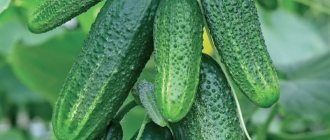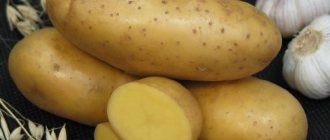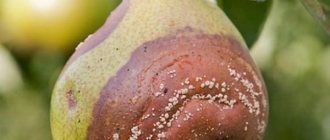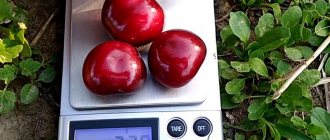Watermelon Ogonyok is famous for its taste and early ripening. Many summer residents love him for this. Let's consider the characteristics of this variety, its advantages and disadvantages, as well as the nuances of cultivation and collection in different parts of Russia.
Watermelon variety "Ogonyok"
watermelon seeds variety “Ogonyok”
watermelon “Ogonyok” has been represented in the State Register of Breeding Achievements for 60 years
Origin of the variety
Watermelon Ogonyok was bred by crossing the Sugar variety and an Asian hybrid. This was done in the Kharkov region (Ukraine) by employees of the Institute of Vegetable and Melon Growing. The variety got its name because of the orange-red color of the pulp, which resembles the color of a light.
It was assumed that this watermelon would be grown in warm southern regions. However, Ogonyok was able to take root both in the Moscow region and in the Urals, and even showed itself well in Siberia. True, growing crops outdoors in cold areas with harsh winters is very difficult, but in greenhouses it is quite possible.
How it was bred and the growing region
The unpretentious watermelon was bred in our country back in Soviet times at the Institute of Vegetable Growing near Kharkov.
It is believed that Ogonyok was obtained by crossing an Asian hybrid and the Sugar variety. It was intended for cultivation in the southern regions.
Gradually its geography expanded. Ogonyok proved himself well in the Moscow region, reached the Urals and ended up in Siberia. But the cold Siberian climatic conditions did not allow melons to be grown in open ground. But the greenhouse conditions turned out to be quite suitable.
Characteristics of Ogonyok
Ogonyok is distinguished by its early ripening - the ripening period of the fruit is approximately 80-85 days. And the watermelon itself looks like a ball: just as round and smooth. The weight of the fruit usually reaches 2 kg (sometimes up to 2.5 kg), and its shell is quite thin, dark green in color. Watermelon pulp is juicy and sweet, but with a large content of small dark brown seeds.
Watermelon Ogonyok can grow both in open soil and in greenhouse conditions. Like all melons, it loves warmth, but can withstand low temperatures for a short time. In central Russia, this watermelon has time to ripen before the onset of the first cold weather. Its yield is up to 2.6 kg/sq.m. m.
Characteristics and description
The variety was bred in the USSR in Ukraine, and was included in the State Register in 1960 for cultivation in the Central Black Earth, East Siberian and Far Eastern regions. It belongs to the early ripening variety; the first fruits can be obtained 71-78 days after emergence.
Description of the variety:
- lashes are short and medium length, the main one is no longer than 1.8 m;
- the stem is thin, slightly pubescent;
- small leaf, heavily dissected;
- fruits are spherical, small;
- the bark is smooth, slightly segmented, thin, dark green in color;
- the pulp is orange-red, very sweet;
- the taste is good.
The yield of the watermelon variety Ogonyok is 1.7-2.6 kg per 1 sq. m with a weight of 1 fruit of 1.7-2.3 kg.
Watermelon fruits of the Ogonyok variety can be transported, but they must be handled carefully, since their bark is thin. Suitable for fresh consumption and pickling.
Features of cultivation in different regions
Since this watermelon has a wide growing geography, the climatic characteristics of each region should be taken into account. For example, in the Moscow region, Ogonyok can ripen both in a greenhouse and in open ground.
But in the Urals you cannot be sure of the ripening of fruits if the season turns out to be rainy and cold. Watermelons will only have time to ripen during hot summers. Therefore, in this region it is advisable to grow this melon crop in closed conditions (greenhouse).
In Siberia, grow these watermelons only in a greenhouse. The climate of the region will not allow the heat-loving culture to develop normally in the open air. In the south, there are no problems with growing Ogonyok.
When to Harvest
The ripening time of fruits differs and depends on the region and time of planting. In the Moscow region, the harvest can be harvested already in July, in the Urals - in August, in Siberia before the first frost in September.
The deadline for harvesting fruits in the greenhouse will come 2 weeks earlier due to early planting, higher temperatures, and the ability to create optimal conditions for growth. Greenhouse Ogonyok is characterized by juicier and tasty pulp.
Watermelons of this variety should be used immediately after harvest. They do not have high shelf life, are poorly stored and are only suitable for quick consumption. But these shortcomings are more than compensated for by the excellent taste.
Every year the market pleases with new varieties of watermelons: square and oblong, with pulp of different colors and shades, unusually colored fruits. But the watermelon Ogonyok does not give up its position. This old, time-tested variety remains a favorite of many vegetable growers.
Advantages and disadvantages of the variety
Analyzing the characteristics of the Ogonyok variety, we can highlight the following advantages:
- early fruit ripening;
- the ability to adapt to different climatic conditions, including sudden changes in temperature;
- resistance to anthracnose and fusarium wilt;
- the ability to withstand the absence of fertilizing and watering for a long time.
As for the disadvantages, they are:
- unsuitable for long-term transportation, since the variety has a very thin peel;
- short shelf life - only 7-10 days.
Watch a review of the watermelon variety “Ogonyok” in the video below:
How to determine the ripeness of berries
Fruit ripening of the watermelon variety Ogonyok is uniform. To determine ripeness, experienced vegetable growers use external inspection:
- the size of the watermelon must correspond to its varietal characteristics; it is better to choose a medium-sized fruit;
- characteristic dark green color of the fruit;
- formation of a hard crust with a dry “tail”;
- resonant sound when tapped due to voids inside;
- the presence of a side light spot when a watermelon ripens on the ground.
If the fruit is thrown into water and it floats up, it means that the watermelon is ready to eat and its ripeness is beyond doubt.
Growing seedlings
In most cases, Ogonyok watermelons are planted in seedlings. To create seedlings, select healthy seeds without any damage. Seeds that are already 2-3 years old germinate best. Fresh seeds will turn into developed and strong plants, but they will not bear many fruits.
How to grow seedlings:
- treat the seeds with a 1% solution of potassium permanganate and leave them to disinfect for an hour, then rinse;
- soak the seeds in a damp cloth in a warm place until sprouts appear;
- prepare the soil for planting - mix humus, peat and sand in equal parts;
- take containers for planting seedlings with a volume of at least 0.6 liters and plant seeds there to a depth of 4 cm;
- keep containers with seedlings at a temperature of about 25-28 degrees during the day, and at night - not lower than 14 degrees;
- water the plants with warm water, trying to avoid overflowing;
- feed the sprouts with mineral fertilizers 10 days after germination and after the same time, do it again.
Keep the seedlings in a sunny, warm place. The window sill located on the south side of the house is perfect for these purposes. When sprouts appear, it is important that the plants get plenty of light, otherwise the seedlings will stretch out.
Since watermelons do not like to be transplanted, grow seedlings in separate pots and without picking. About 7 days before planting in open ground, harden the seeds at a temperature of 0 degrees (you can use a refrigerator for this purpose).
Greenhouse care
The process of watering and fertilizing is the same as for open ground. The disadvantage of greenhouse cultivation is the lack of bees to pollinate the flowers. In a greenhouse, plants must be pollinated by hand. Apply the stamens of male flowers to the pistils of female flowers.
Caring for watermelons in a greenhouse
Note! Watermelons need to be pollinated at a temperature of 20-22 degrees.
From time to time, the greenhouse should be opened to harden the plants and ventilate. In small greenhouses, the trellis method of tying lashes is suitable. The lash should be pinched after the fourth ovary; you should not leave more than 5 pieces on one plant.
Important! To ensure that watermelons are not one-sided and ripen evenly, they need to be turned periodically.
Rules for planting watermelon
To get a good harvest of watermelons, you need to follow certain planting rules. Let's look at how growing melons outdoors differs from planting them indoors.
In the greenhouse
The easiest way to grow watermelons is in a greenhouse. It is in an enclosed space that all the necessary conditions for the proper development of fruits can be created. If it is not seedlings that are being planted, but seeds, then they can be transferred to the greenhouse as early as April.
If the seedlings are transferred, then the optimal time for planting is considered to be the beginning of May. The distance between the bushes should be 70 cm and the same between the rows. In a greenhouse, you can reduce the area where melons are placed by tying the plants to a trellis.
In the open ground
Plant seedlings outdoors in late May - early June. The sprouts should already be 30 days old by this time. The soil must be well warmed up in any case, otherwise the roots of the melon crop will not be able to grow and develop normally. The soil needs to be light, neutral or slightly alkaline in consistency, without the formation of stagnant moisture.
The landing site should be level and sunny, with a large area. This is necessary, since melons take up quite a lot of space. Do not plant watermelons where other pumpkin or nightshade crops have already grown in the last 3 years.
Features of cultivation:
- the distance between bushes should be 0.8-1 m, and between rows - 1.4-1.5 m;
- add 2 handfuls of humus and a pinch of fertilizer with minerals into the prepared holes;
- then pour out 2 liters of warm water and plant the seedlings, deepening them only to the lower leaves.
Watermelon is a heat-loving crop, so if there is a threat of the temperature dropping below 15 degrees Celsius, cover the seedlings with film or any non-woven material. This is especially important if the sprouts have not gone through the hardening stage.
The nuances of growing a variety
To achieve positive results and grow large, tasty watermelons, the gardener must know all the features of growing Ogonyok.
We grow seedlings
Ogonyok seeds are sown for seedlings in the second half of April so that the seedlings do not have time to outgrow before planting. It is advisable to preheat the seeds at a temperature of +60 C degrees for several hours. Then you need to “etch” them from fungal diseases by soaking them for half an hour in a pink solution of potassium permanganate.
And only then the planting material is treated with a growth stimulant to increase germination. It is advisable to carry out scarification, used for seeds with thick skins. It helps the seeds germinate faster and involves damaging the shell, usually by pricking the “nose” of the seeds.
Watermelon is a powerful crop, so deep pots or 0.5 liter plastic cups are used for sowing. The cups are filled with substrate, compacted a little and spilled with water. When the soil settles, make a small hole, 3-4 centimeters deep, and place a seed at the bottom.
Then the hole is covered with substrate and watered again. For rapid seed germination, a high temperature is required: +28 C...+30 C degrees, then seedlings appear within a week. After emergence of seedlings, the air temperature should be +20 C...+22 C degrees during the day and +17 C...+18 C degrees at night. At higher temperatures and lack of lighting, the seedlings will stretch out and be weak.
Preparing beds and choosing a planting site
Before planting, the beds are prepared in advance. First, weeding is carried out to remove weeds. In the fall, organic matter (rotted manure) and mineral complex fertilizers are added. After application, the beds are deeply plowed or dug up.
See also
Rules for growing watermelons in open ground, how to form and care
Read
Planting seedlings
The seedlings are hardened within a week, and weak or diseased plants are discarded before planting. 2-3 hours before planting, the cups are spilled with a solution of a growth stimulator to overcome stress and quickly adapt after planting. For watering at the root, use the drug Viva, but you can spray the leaves with the stimulant Megafol. When planting, the substrate should not be wet, otherwise it will be difficult to get it out of the cup.
When grown in cups, it is slightly crushed, turned over, and the seedling is fixed between the fingers.
Then lightly tap the bottom of the glass with your palm. Properly grown seedlings with well-developed roots will easily free themselves from the cup. If the roots below are very tangled, straighten them a little and plant them in previously prepared planting holes. Then sprinkle with soil and water the beds generously.
Sowing seeds
In the southern regions, watermelons can be planted by direct sowing of seeds in open ground. Sow at soil temperatures above +16 C degrees. Necessary conditions for growth are full sun and warmth. As well as regular watering until flowering. The preferred soil type is sandy loam, but this is not essential. It is not advisable to plant on heavy, clay soils. Planting is carried out to a depth of 5-6 centimeters. The sowing density is up to 10 seeds per linear meter.
Transplanting seedlings to a permanent place
To grow in open ground, Ogonyok seedlings are planted with well-formed 3-4 true leaves. Her age at that time will be 30-35 days. When planting, plants are buried down to the cotyledon leaves, this promotes the formation of additional roots. Seedlings are planted according to 2 schemes: square-cluster and row.
With the first, the distance between plants is from 0.7 to 2.8 meters. In the second scheme, the distance between plants in a row is 1-2 meters, and the row spacing is from 1.5 to 3.0 meters.
Sowing seeds
How to plant watermelon seeds Ogonyok:
- start planting seeds in open soil in mid-April - early May;
- the ground should already be well warmed up;
- dig holes for the seeds (distances are the same as when planting seedlings) and pour water into them;
- loosen the soil and place 2-3 grains in the hole at a short distance from each other;
- cover them with soil.
How to prepare seeds for planting?
Also check out these articles
- Cucumber variety Claudine F1
- Chicken manure as fertilizer
- How and what is the best way to feed melons in a greenhouse
- Description of the Manchurian quail breed
Regardless of where the seeds are planted (seedlings or open ground), they need to be processed, otherwise they will take a long time to germinate. The most basic method is to soak them in water for several days so that they germinate. To do this, the seeds are laid out on a wet cotton cloth. The seeds are then wrapped and left for several days. Before planting, they need to be soaked in potassium permanganate overnight and washed in the morning.
Preparing watermelon seeds
When planting in the middle or northern zone, you also need to harden them for several days at a temperature of 0 degrees (you can use the refrigerator).
In order to get a harvest as early as possible, it is worth planting not seeds in the ground, but ready-made seedlings; they take root faster and begin to grow. Seedlings are prepared using the usual method. Seeds are sown in peat cups, covered with film, and placed in a warm place. After they hatch, they need to be opened and watered from time to time. 10 days before planting in the ground, seedlings are hardened off.
Basics of care
Proper care of melons will help you reap a good harvest of watermelons. You need to water them on time, remove weeds, loosen the soil and feed them with the necessary fertilizers. You also need to be able to form them correctly.
Watering
Water Ogonyok watermelons only with settled, warm water. It especially needs moisture during the period of flowering and the appearance of ovaries. In greenhouses, irrigate as the soil dries, and in the open air - depending on precipitation and air temperature. If it rains frequently, then there is no need to water the plant.
Feeding
You need to feed the watermelon Ogonyok three times:
- 10 days after planting - add 30 g of ammonium sulfate, 45 g of superphosphate and 15 g of potassium salt (dilute this composition in a bucket of warm water);
- during growth and formation of ovaries - 10 g of superphosphate, 20 g of ammonium sulfate and 35 g of potassium salt;
- 10 days after the 2nd feeding , apply a similar composition again.
Formation
To get a harvest in the northern regions, the Ogonyok watermelon needs to be properly shaped and the fruit load monitored. Otherwise, the watermelons will not have time to ripen normally. It is most convenient to grow them on a net or trellis.
How to shape watermelons correctly:
- since Ogonyok’s fruits only form on the main stem, pinch off all the side stems once a week (they are not needed);
- leave no more than 2-3 fruits on one stem after they ovary, otherwise the watermelons will be too small;
- During the growth of the fruit, pinch the top, as its growth is no longer needed.
After forming the watermelons, place the fruits in nets to prevent the vine from breaking off. In this state, watermelons have no contact with the ground and do not rot. If there is a lot of space on the site, leave long stems curling along the ground.
Further care of the crop
Growing and planting seedlings or seeds in the ground is only the initial stage in growing watermelons. To obtain a rich harvest, it is necessary to carry out a number of agrotechnical measures during the season.
Watering
Some gardeners believe that this crop can grow without irrigation. But this statement is wrong, especially due to the increase in average temperatures in summer. And, of course, there is no way to grow large, fleshy fruits without irrigation in the southern regions. Young seedlings, especially in the first time after planting, require regular and abundant watering, up to 3-4 times a week.
When flowers begin to bloom on watermelons and then fruits begin to set, the frequency of watering is reduced to 3-4 times a month.
With the further development of watermelon, watering can be slightly reduced. Here the gardener himself determines the frequency - depending on the region, temperature and amount of precipitation. On large areas, without the possibility of regular moistening, 3 abundant waterings are carried out, at different stages of crop development.
See also
How often should you water watermelons in open ground, rules and timing?
Read
Feeding
You can feed when the seedlings reach 10 days of age, then treat them every 15-20 days, depending on the stage of development of the watermelon. At the beginning of the growing season, we treat with fertilizers with a high nitrogen content, for example, Plantafol 10.30.10, at the time of flowering and fruit filling - phosphorus-potassium or universal. Plantafol 0.25.50 and Plantafol 5.15.45 are suitable.
Formation
To speed up fruit growth, pinch watermelon vines and leave 4-5 leaves above the watermelon. Weak, thin and sterile shoots are cut out to zero.
Treating plants against diseases and pests
Like many other crops, watermelons are affected by diseases and pests. Requires protection from aphids, cutworms, spider mites, sprout flies, wireworms, thrips and meadow moths. It is necessary to treat watermelons with insecticides several times during the season, but not at the time of fruit ripening. Aktara, Confidor, Decis Forte, Actellik are suitable. If pests are detected immediately at the time of ripening, then only biological products should be used. For example, Aktofit, Fitoverm.
The diseases that affect watermelons are partly similar to diseases of cucumbers. Ogonek is resistant to fusarium and anthracnose, but can be affected by powdery mildew, bacteriosis, botrytis, mosaic and spotting. For treatment and prevention, several treatments with fungicides are necessary. Use copper sulfate, Ridomil Gold, Acrobat. Before harvesting, only biological products are allowed to be used.
Diseases and pests
Watermelon Ogonyok is most often affected by powdery mildew, angular or olive spot, and anthracnose. Cucumber mosaic or root rot may also appear. Control fungal diseases with fungicides such as Bordeaux mixture or Fundazol.
As for pests, aphids, cutworms and wireworms are dangerous for melon crops. Destroy them with insecticides (for example, Decis). Timely removal of weeds, periodic loosening of the soil and compliance with crop rotation also help.
Watermelon seeds Ogonyok
Watermelon Ogonyok is a common variety; any summer resident or garden owner can afford to buy the seeds. Before you buy seeds, ask yourself a question: how often will you be in your garden or dacha at the time of harvest. The variety is early ripening and may become overripe.
Watermelon seeds Ogonyok must be tested before planting: place them in a salt solution and remove those that float to the surface. It is recommended to keep the seeds in a weak solution of potassium permanganate for about half an hour. Before planting, the seeds are soaked until sprouts appear.
Advice from experienced gardeners
Sometimes it happens that even if all the rules are followed, watermelons do not grow as desired or produce a smaller harvest. This may be due to ignorance of some nuances or tricks that experienced gardeners know.
So, advice from experienced people:
- grow watermelons from seedlings, not from seeds - in this case the fruits will be larger;
- make sure that the fruits do not interfere with each other, that is, plant melons over a large area;
- systematically loosen the soil to allow air to penetrate into the soil - do this also 30-40 minutes after watering;
- turn watermelons over as they ripen so that the fruits ripen evenly and if you do not want them to rot or be attacked by ants and other insects;
- do not over-ripe the harvest in the beds - Ogonyok can very easily overripe;
- protect the melon from birds that can peck the fruits;
- regularly remove all weeds;
- For faster pollination of the plant by bees, spray the melon with honey or sugar solution.
Some gardeners advise mulching the soil under watermelons. This makes it possible to retain moisture, various nutrients and protect fruits from rotting in damp soil.
Where can you plant watermelon?
You can grow Ogonyok watermelon in open ground or in greenhouses. It is unpretentious, so it does not need special conditions, but the presence of sunlight and heat is required. If this cannot be achieved naturally in open ground, greenhouses are used. There is an opportunity to create additional lighting, warmth, and so on.
Germinating watermelon seeds
The best predecessors: wheat, legumes, perennial grasses. Bad predecessors: nightshades, melons.
The soil is light (sandy, sandy loam) so that oxygen can nourish the roots. If there is none on the site, you can either dilute the soil in the place where the crop is planted with sand, or carry out weeding frequently. Shortly before planting, but preferably in the fall, the soil is dug up and fertilized with humus. Fertilizer is applied at the rate of 7 kg per 1 sq. m.
| Our readers liked the articles: How to grow watermelons in the Moscow region - https://www.www.fermerok.info/kak-vyrastit-arbuzy-v-podmoskove How to grow watermelons in open ground How to plant watermelons with seeds correctly |
Reviews of watermelon variety Ogonyok
★★★★★
Mikhail, 48 years old, driver, Balashikha. I planted the Ogonyok variety at the dacha to pamper myself and my family with watermelons.
I can say that I am satisfied. The fruits are small, but tasty and ripen early. The main thing is not to overexpose them in the garden, otherwise you will have to eat overripe watermelons. ★★★★★
Irina, 39 years old, salesperson, Belovo. In our climate, watermelons can only be grown in greenhouses.
That's what I do. The light is quite unpretentious and quite easy to care for. I plant a little, but this amount is enough for me and my family to enjoy some delicious food. Hide
Add your review
The Ogonyok variety is loved by many gardeners for its ease of care, resistance to adverse conditions and pleasant taste. Take into account the recommendations of experienced melon growers and follow the rules for growing the crop. In this case, a good harvest will not be long in coming.
0
0
Copy link
Reviews
What do Russian gardeners say about the Ogonyok variety? Let's look at a few reviews from online forums:
Alexey, Moscow: “Watermelon Ogonyok is my favorite. The yield is always high; I collect 8–10 fruits from the garden. The taste is excellent, very sweet. We eat the fruits with the whole family and distribute them to friends.”
Maria, Orel: “I grow the variety in seedlings in a greenhouse. I water only with warm water, fertilize with liquid organic matter and superphosphate. The variety did not suffer from any diseases, there were no pests.”
Nikita, Chelyabinsk: “ Ogonyok disappointed me. In the cool Ural summer, the fruits set slowly and the harvest was average. I rated the taste 3 out of 5.”
Advantages of watermelon “Ogonyok” from reviews of melon growers
One of the main positive qualities of Ogonyok is its resistance to low temperatures, especially in late spring - early summer, when plantings are often damaged by return frosts. Watermelons of this variety can easily tolerate a slight drop in temperature, but in order to preserve the harvest, it is necessary to cover the seedlings with covering material.
Mulching the bushes is an important undertaking; it protects them from frost, prevents weeds from taking over the area, retains moisture in the soil and prevents the formation of a soil crust. Therefore, experienced melon growers always use mulch as a significant help and assistant in improving water and air exchange processes in soil.
Features of care
Proper care is an important measure in growing watermelons, and the Ogonyok variety is no exception. Farmers pay special attention to watering, fertilizing, bush formation, disease prevention and control.
Watering and fertilizing
Watermelon can only be watered with warm water. Its temperature should not be lower than +25°C. The plantings are moistened in the evening. The bushes can be irrigated or use the drip irrigation method.
The frequency of watering depends on the growth phase.
Before fruit ripening, moisture is moderate:
- at average air temperature - once every 1-1.5 weeks;
- on hot days - every 5 days.
When the berries are actively developing, watering in the garden is reduced, and in greenhouses it is completely stopped. Farmers periodically apply fertilizers after watering.
Important! Experienced farmers do not recommend using manure to feed watermelons.
The standard feeding scheme is as follows:
- a week after planting;
- 2 weeks after the first fertilization;
- 12 days after the second fertilization.
Video: Feeding watermelon for a good harvest
Suitable fertilizers include:
- humus;
- ammonium nitrate;
- diammofoska;
- humus;
- chicken droppings.
Bush formation
Watermelon Ogonyok is formed into one stem. The side lashes are pinched. There should be no more than three ovaries left on the bush.
Bush formation scheme
Pest and disease control
The variety is resistant to a number of dangerous diseases, including:
- fusarium;
- anthracnose
Other diseases are sometimes found on watermelon bushes:
- Root rot . Symptoms: leaves turn yellow, dark brown wet spots appear, the plant emits a putrid odor. Treatment: treat the plantings with Fundazol or copper sulfate.
- Bacteriosis . Symptoms: white spots are observed on the leaves, then holes appear in the leaf blade, the fruits become soft. Treatment: remove diseased plants, treat healthy ones with Fundazol.
- Powdery mildew . Symptoms: the leaves become covered with whitish spots that look like a scattering of flour. Treatment: treat the plantings with Topaz.
The gardener should also be wary of pests.
The most dangerous are wireworms and melon aphids:
- Wireworms . Symptoms: Brown worms appear in the soil - they will later develop into click beetles. Treatment: use an insecticide, such as Decis.
- Melon aphid . Symptoms: Small green insects on leaves and stems. Treatment: apply the Fitoverm insecticide.
To avoid the appearance of parasites and the development of diseases, pay attention to the following preventive measures:
- follow the rules of crop rotation;
- before sowing seeds for seedlings, disinfect the substrate;
- disinfect seed material with Fitosporin;
- do not use uncleaned tools for work;
- clean and dig up the area before planting in open ground;
- do not water the ridges using sprinkling method;
- water the plantings with warm water;
- destroy seedlings with obvious signs of disease (plaque, rot, spotting) immediately;
- monitor the plants and remove diseased bushes from the beds.
Did you know? Watermelons are more often than other products used for carving - figured carving on vegetables, fruits and berries.
How to grow watermelon on the balcony
To grow a watermelon on the balcony, you need to take all stages responsibly:
- selection, preparation, germination of seeds;
- growing seedlings;
- caring for plants on the balcony.
Seed preparation
In many ways, the success of growing watermelon on the balcony depends on the correct choice of seeds. Select the variety that is optimal for the growing region.
The Ogonyok variety performs well in almost all regions. Its weight is from 2.5 to 5 kg, the skin is thin, the shape of the fruit is round.
Watermelon variety "Ogonyok"
In the middle zone and northern regions, greenhouse varieties are well suited for this:
- “Sibiryak 97” with fruits weighing up to 4 kg, sweet aromatic pulp and a thin green crust. Not affected by root rot and other diseases. Can withstand short frosts.
- “ Lezheboka honey” is an early ripening hybrid with round, sweet fruits weighing 3-5 kg and small seeds. The skin color is green, with dark stripes.
- The Arizona variety can be chosen if you expect to get pods weighing up to 8 kg. The time from sowing seeds to ripening is 85 days. Oval shape, medium thick peel. The variety is resistant to fungal diseases fusarium and anthracnose, which can destroy plants at high humidity and temperature.
Watermelon variety "Arizona"
It is unlikely that you will be able to get a fruit weighing 8 kg on the balcony, but with good care it will grow larger than the same “Ogonyok”.
When choosing a variety, take into account that sometimes it is better to get several small but tasty fruits than one large but unripe one. Therefore, it is better to start with varieties with small, round, thin-skinned fruits of early ripening.
You cannot take seeds of an unknown variety for cultivation from berries previously purchased at the market. There is a high probability that this is a hybrid, and its seeds do not convey the varietal characteristics of the mother plant.
Seed preparation
They inspect the seeds and immediately discard damaged and unripe ones. The rest are wrapped in gauze or cotton cloth and immersed in a pink solution of potassium permanganate for 20 minutes.
Remove, lightly dry and place in the same cloth in a warm place. Periodically check to see if the seeds are dry and slightly moisten the fabric.
Seeds of watermelon
When the seeds have hatched, they are sown in previously prepared containers. Don't wait for the sprouts to get big. In this case, they will become brittle and easily break during sowing.
First, you can sow the seeds in ordinary 0.5 liter plastic cups, filling them with peat or universal soil from the store. A hole is made in the bottom to drain excess water. Any loose soil will do. Pour soil into cups, make a hole and immerse the sprouted seeds to a depth of 2 cm. Sprinkle with soil and compact. If the soil is dry, water it.
Place the cups in a tray and cover with a plastic bag. Place in a warm place. It turns out to be a mini-greenhouse in which sufficient humidity and temperature are maintained. It is important here not to over-moisten the soil, because the seeds may rot. The soil should be crumbly and not clump together. The temperature is maintained within 25 degrees.
You can skip the germination stage in tissue by immediately sowing several seeds into glasses. If several of them sprout, the strongest sprout is left, the rest are torn off. It is more advisable to use this method if the number of seeds is sufficient. Instead of plucking the extra plants, you can replant them, but they do not take root well.
When the sprouts appear above the ground, remove the film and transfer the cups to a cooler place, you can go straight to the balcony. If the sprouts are too warm, but not enough light, they will stretch upward, become frail and thin.
To successfully grow watermelon on the balcony, you need to have at least 12-14 hours of daylight. If natural light is not enough, turn on special phytolamps. They provide light with characteristics similar to that of the sun. If there are a lot of cloudy days, you can turn on the lamp all day.
Installing reflective screens has a good effect. They will help increase the amount of light the watermelon receives. The area of each of them must be at least 1 m2. Install the screen so that the sun's rays hit it evenly throughout the day.
Soil preparation
When the seedlings have 4 true leaves, they are transplanted to a permanent place in large tubs or pots. You can buy soil at a gardening store or prepare it yourself. To do this, take sandy loam and mix it in equal parts with humus. Add a handful of crushed wood ash. It will serve as a source of potassium for the plant. If there is no sandy loam, take turf soil and sand in equal parts. The acidity of the resulting composition should be within 6-6.5 pH.
The prepared soil is disinfected by pouring boiling water over it, soaking it in the microwave for up to 20 minutes, or steaming it in a water bath for at least 1.5 hours. Once cooled, pour into prepared dishes. If it was used to grow plants last year, it also needs to be disinfected: pour boiling water on it or wash it thoroughly with special products. A drainage layer consisting of gravel, broken ceramics and brick is laid at the bottom.
Half an hour before planting the seedlings, you can water them. But sometimes this leads to the earthen lump crumbling and the roots being exposed. Such a plant will not tolerate transplantation well and will lag behind in growth and development. Therefore, sometimes it is more advisable not to water it before planting, but to lightly crush the body of the glass with your hands so that the soil moves away from it, but the lump of earth does not collapse.
Prepare a hole in the ground. Carefully remove the seedling from the glass and place it in a tub. It’s not scary if it is not located vertically, but slightly at an angle to the surface. Sprinkle with earth and water.
Caring for watermelons on the balcony
Watermelon does not like waterlogging, but it can die from drought. In the field, its root penetrates deep into the ground, extracting moisture from it. On the balcony he does not have such an opportunity. Therefore, periodically water the soil in the tub, but so that it is not wet and does not stagnate. Remaining moisture goes into the pan through holes made in the bottom.
Form a plant, leaving one of the strongest stems. They tie it to the trellis with fabric strips.
Maintain a daytime temperature of 25-30°C. At night it should not drop beyond 18°C. It is especially important to observe these conditions during the formation of the ovary.
When plants bloom, they need pollinators. If possible, open the balcony to attract insects. If natural pollination cannot be ensured, artificial pollination is carried out.
Watermelon flowers are unisexual, male and female. They can be distinguished by their appearance; the male ones have a thinner petiole, while the female ones have the rudiments of a small watermelon at the base. They pick the male flower, tear off the petals and pollinate the female flower. You can perform the procedure with a soft brush.
When the ovaries are formed and reach the size of an apple, they are placed in nets and suspended from a support. They will hold the fruits, reducing the load on the stem.
Remove excess leaves, leaving no more than two fruits on each vine. The number of leaves should not exceed 11 pieces. Pinch the top. From this moment on, all the forces of the plant will be used for fruit growth.
Water the watermelon once a week, pouring out one and a half liters of water at a time. Carefully loosen the soil to improve air access to the roots.
How to grow pumpkin on the balcony
To understand how to grow a pumpkin on the balcony, you need to know the conditions under which it grows in the garden.
- The soil should be nutritious, pH 6.0. You can make it yourself by mixing 2 parts of garden soil, 1 part each of compost or humus, peat and sand.
- The problem with growing pumpkin is its rapid growth and huge leaves.
Pumpkin varieties for the balcony
You should not sow pumpkin seeds grown in your garden on your balcony. They usually have a very long growing season. In addition, it will not be possible to provide the plant with the volume of soil necessary for normal development. It is better to buy special varieties for balconies, or, as a last resort, hybrids or early ripening varieties.
They take up less space and do not require the formation and regulation of the bush.
- “Amazon” is an early ripening bush variety. It takes about 8 days from sowing to ripening. The shape of the fruit is spherical, the color is bright orange, weight up to 1.5 kg.
- “Ambar” is a medium-ripening variety. The weight of the fruit is up to 3 kg, the skin is bright, dark green, with black spots. The pulp is orange, sweet. Stored until spring in a dry place.
- “Smile” is an early variety with short vines. Fruit weight is up to 1.5 kg, the pulp is sweet, with a melon aroma.
- “Medicinal” is an early ripening variety. Fruit weight is 4-5 kg, the flesh is orange.
- Varieties of decorative pumpkins of various shapes and colors have been created. Their fruits are inedible, but they will help decorate your balcony in the fall. And in winter, they decorate the apartment with beautiful small pumpkins, creating original compositions from dried flowers, stones, and branches.
Decorative pumpkin
Seeds need to be sown 2-3 weeks before planting in a permanent place. At this point, the seedlings should have 1-2 true leaves.
Pour soil into peat pots. There is no need to remove seedlings from them, so the plants will better tolerate transplantation. Place the seeds flat in holes up to 2 cm deep. Sprinkle with soil. Cover with film and wait for the seeds to germinate. After this, cut the film and leave it on the pot. This will maintain moisture and constant temperature.
Features of the variety
A watermelon variety like Ogonyok ripens in about 80 days. It is characterized by early ripening and good resistance to adverse weather conditions, due to which harvesting is often faster than many popular foreign crops, including Trophy, Victoria and Crimson Sweet. In its shape, this variety of watermelon is a spherical berry weighing from 1.5 to 2.5 kg. The variety is distinguished by bright red pulp with a small number of seeds, which is why it got its name.
A watermelon variety like Ogonyok ripens in about 80 days.
According to gardening experts, the domestic Ogonyok is a mixture of the Sugar Baby variety with one of the Asian hybrids. The rind of the Ogonyok watermelon is quite thin, brown-green in color, which gives it wonderful taste, but can create problems during transportation. Even due to minor damage, the fruit quickly becomes unusable and becomes a breeding ground for pathogens. Reviews about the Ogonyok variety are extremely positive. Despite the fact that this is not a very suitable option for trade, such watermelons, immediately after ripening, become a good solution for serving the family table.
Conditions for growing melons and melons at home
The homeland of watermelon is hot Africa. Therefore, to successfully grow watermelons on the balcony, you need to provide them with high temperature and sufficient light, and the soil in which it grows must be well heated.
It is best to grow watermelons on a balcony on a south or west window.
As a last resort, you can try to grow in the east or north, but here you cannot do without intense lighting.
Melons are plants with long vines that are located horizontally on the ground, covering the entire space with leaves and shoots. On the balcony they will have to be grown in one or two stems, as in a greenhouse. You need to direct the shoots vertically, using a support, and remove excess shoots.
It is better to install a trellis to support plants at a certain distance from the wall. This will improve ventilation of the bush and prevent the occurrence of diseases. They usually occur where stale air collects.
The larger the container in which the watermelon is grown, the better for it. After all, the root of the plant reaches a length of 1 m, and the lateral ones - 4-5 m. The volume of the entire root system of an adult watermelon in the city is 7-10 m3. It’s good if you have a tub of 100 liters.
You can put together a box 50 cm wide and 70 cm high. It is possible to grow a watermelon in a smaller pot, but its fruits will be more like apples, and the taste will be very different from the field one.
Holes are made at the bottom of the dish for ventilation. Excess water will run into the pan, which also needs to be prepared in advance.
In the southern regions, glazing of the balcony is not necessary. Here it is important to pay attention to how early frosts come in the fall. If in the spring you can protect a young watermelon plant from frost and cold by installing it on a windowsill, then in August this will not work: moving a huge vine with fruits tied to a trellis is unrealistic.
Successful cultivation of watermelon at home is possible at a temperature of 25°C. Some deviation in both directions is allowed, but at a temperature of 15°C its growth stops, and at 10°C it may die.
Feeding watermelon
Watermelon does not need to be fed. But then its fruits will certainly be small. When choosing fertilizers, everyone decides for themselves whether they should be organic or chemical.
When choosing chemicals, the main thing is not to add substances in doses greater than the norm indicated on the package. This is harmful to both the plant and the owners. You can use Kemira complex mineral fertilizer.
The first feeding is carried out in cups. If you don’t have time before replanting, wait at least a week for the plant to take root and the root system to get stronger. In the first stages of development, watermelon needs to receive more nitrogen, and during the formation of the ovary - phosphorus and potassium.
Fertilize again after 3 weeks. During this period, nitrogen is not needed; they are limited to a mixture of potassium and phosphorus fertilizers.
For those who are afraid to use mineral fertilizers, you can apply organic ones. They are easy to prepare yourself. To do this, collect the above-ground part of the weeds and grass mowed with a lawn mower. Place it in a jar and close the lid.
Install on the balcony or outside the apartment, because the smell during fermentation will not be very pleasant. But the resulting composition contains a sufficient amount of nitrogen and potassium. There are also organic acids that promote plant growth, and antibiotics that suppress the development of fungal diseases.
There will be little phosphorus in such fertilizer. Therefore, it is advisable to add superphosphate to the infusion, 50 g for every 10 liters of infusion.
Fertilizing with humus infusion will be useful for watermelons on the balcony. It can be purchased at the store or pre-prepared from organic waste.
Disease and pest control
If gray or brown spots appear on the leaves and stem of the watermelon, this means that a fungal disease has occurred: powdery mildew, anthracnose, fusarium. It is better to fight fungi on the balcony without using chemicals. It is recommended to spray the plants with a solution of Fitosporin.
Biofungicide for plant protection
Before planting, for prevention, the soil is watered and the plants are treated with HOM or the same Fitosporin.
Sometimes plants are affected by pests. These can be gnawing cutworms, whiteflies, melon aphids, and spider mites. To control pests, it is best to use the biological product Fitoverm.
When the watermelon grows to a decent size on your balcony and its tail begins to dry out, pick the fruits. They can be eaten immediately or stored for no longer than 2 months in a cool, dry place.
Preparatory work
In order for the plant to begin to grow, the site must be prepared in advance. The seeds are also prepared. These measures will help avoid problems in the development of plantings in the future.
Site selection and preparation
Ideal conditions for planting watermelons:
- the area is not shaded;
- the soil is sandy or sandy loam;
- acidity about 7 pH;
- Previously, wheat, legumes, onions, cabbage, and alfalfa grew on the site.
Important! If you do not have a site with such parameters at your disposal, it is better to resort to greenhouse cultivation. In the greenhouse, you can adjust lighting, temperature and other important parameters.
The site needs to be prepared in the fall:
- dig up the soil;
- feed the soil with humus and complex mineral-based fertilizers.
Seed preparation
Prepare seeds for seedlings and for sowing in open soil before planting:
- Pack the material according to size.
- Soak the grains in water. Any that float can be thrown away.
- Dry the seed and scald it with water at a temperature of +60°C.
- Soak the seeds in a solution of potassium permanganate.
- Wrap the grains in damp gauze. When sprouts appear, watermelons can be sown.
How to grow melon on the balcony
Melon, beloved by many, also belongs to the Bakhchev family. To grow successfully, it needs the same conditions as a watermelon. But before you grow melon on the balcony, you need to choose the right varieties.
Varieties of melons for the balcony:
- “Altaiskaya” is an early ripening variety with an average number of shoots. The fruits are orange or yellow, oval, weighing about 1 kg. Ripen 70 days after sprouts appear. The variety is resistant to diseases.
- “Rime” is an early ripening variety with long vines. The ripening period is about 90 days after the sprouts appear. The fruits are round or oval, yellow, orange, with a mesh pattern on the thin bark. The pulp is white, very sweet. Needs fertilizer and watering. Disease resistance is average.
- “Kolkhoznitsa 749-753” is a mid-season self-fertile variety. The fruits are small, spherical, yellow-orange in color with dense, sweet pulp. The variety is resistant to anthracnose and angular spot.
Features of growing melon on the balcony
The ripening period of melon, depending on the variety, ranges from 2 to 6 months. The root system of the plant is superficial. It weakly absorbs moisture and evaporates it twice as fast as a watermelon. Therefore, the melon needs water much more than the watermelon. But you don't need to fill it up.
Add water at a temperature of at least 22°C only when the top layer of soil dries out. When it is absorbed, lightly loosen the soil to provide air access to the roots.
To grow a melon on the balcony and get the fruits, you need to know what it doesn’t like:
- dense soil with high acidity;
- stagnant air;
- temperature below 20°C;
- watering with cold tap water;
- applying fresh manure;
- frequent feeding.
Preparing Melon Seeds
It is better to sow melon seeds collected independently in the second or third year. Then the plant will have more female flowers.
It is better to sow in February. Then the melons will have time to ripen before the cold weather, and the seedlings will receive a sufficient amount of light. If you sow the seeds earlier, you will have to supplement it with a phytolamp, because the daylight hours in January are too short.
Disinfect the seeds in a solution of potassium permanganate. Then soak in clean water for 12 hours, remove and ventilate every 4 hours.
The stratification procedure (keeping in the refrigerator for 2-3 days at a temperature of 1-3 degrees below zero) will make the plants more resistant to cold.
The further process of germination of melon is the same as for watermelon. The minimum volume of containers in which seedlings are planted on the balcony is 45 liters.
Caring for melons on the balcony
Before fruit formation, it is recommended to limit watering so as not to provoke rapid growth of stepsons, and there will be few fruits and their weight will be small.
You need to feed the melon; it is better to alternate organic matter and mineral fertilizers. But an excess of nutrients will be destructive; a lot of nitrates will accumulate in the fruits.
Melon is more often affected by fungal diseases than watermelon. They appear as gray, brown spots on leaves, stems and fruits.
The most common diseases are:
- Powdery mildew.
- Anthracnose.
- Fusarium.
It’s easy to tell when a melon is ripe. It will change color and emit a pleasant aroma. They pick it and eat it.
How to grow Torpedo melon:
Planting seeds
Of all the melons, domestic gardeners especially highlight the Ogonyok watermelon, which is grown in open ground or in greenhouses. Seeds should be planted in the second half of April or at the very beginning of May, when the earth is already well heated by the sun's rays. Seedlings can be planted until the beginning of June. When planting, watermelon bushes should be placed 1 m apart from each other. The distance between rows should be approximately 1.5 m in width.
Also read: Using regular black bread as a top dressing for tomatoes
It is recommended to grow these melons in light and permeable soil areas
To grow a healthy crop, it is imperative to treat the seeds before sowing. They can be soaked in a weak solution of potassium permanganate overnight, then rinsed with clean water and dried. Hardening of melon seeds at zero temperature, as is usually customary, is not required in this case, since Ogonyok is considered quite cold-resistant.
It is recommended to grow these melons in light and permeable soil areas. If you feel that the ground has not yet warmed up enough, you should cover it with oilcloth until the first shoots appear. It is important that the temperature at night does not fall below +15°C, otherwise you will have to wait a very long time for seedlings. The planting depth should be about 10 cm. Planting Ogonyok watermelon bushes in greenhouses follows a similar pattern. If there are trellises, the fruits can be hung in nets.
Growing seedlings is recommended for those who want to enjoy ripe watermelon fruits earlier. The bushes are germinated at home until 3-4 leaves appear and planted 2-3 weeks after the last frost. After the stem is formed, the side shoots should be removed, leaving no more than 3 ovaries on the bush. It is important that the stem sits firmly in the ground and does not turn over when exposed to wind.
Growing methods
Agronomists distinguish two ways to grow Ogonyok watermelon: seedlings or sowing in the soil. Depending on the climate, the crop can be grown indoors or open. In the middle zone, a vegetable garden is suitable for growing, and in the northern regions, a greenhouse is the best choice.
Seedling method
The seedling method is more reliable than sowing in the ground. Stronger seedlings take root and grow faster.
Also pay attention to such varieties of watermelons as Producer and Kholodok.
Landing dates
As mentioned above, seedlings are sown between April 1–10. By the end of May - beginning of June, the seedlings will be ready for planting in the greenhouse or garden.
Landing technology
The technology for sowing seedlings is as follows:
- Place a peat tablet in a glass or small pot. A substrate made of peat, soil and sand in proportions of 1:1:1 is also suitable.
- Deepen the seed 3–5 cm into the soil mixture or place it in a hole in a peat tablet.
- Moisten the crops with a spray bottle.
- Cover the pot with film.
Seedling care
In order for seedlings to grow healthy, they must be properly cared for. At first, keep the pot covered with film in a dark place with a temperature of +25°C. When the first shoots appear, remove the film and move the pot to the light. Moisten the crops periodically. When 3 leaves appear, feed the seedlings with complex mineral fertilizer. Apply fertilizer a second time 14 days after the first.
1.5 weeks before planting in the soil, begin to harden the seedlings. To do this, the pot with the seedling must be taken outside. On the first day, leave it outdoors for 1 hour. Every day, increase the time you spend outside by 1-2 hours.
Read more about the technology of growing and caring for watermelons.
Planting seedlings in the ground
Plant seedlings in open soil according to the following instructions:
- Dig holes in a checkerboard pattern 0.7 x 1 m.
- Remove the seedlings from their pots.
- Without removing the earthen ball, deepen the seedlings 10 cm into the hole.
- Fill the hole with soil.
- Water the plants.
Seeds directly into the ground
At the end of spring the soil will warm up to +15°C. Now the seeds can be planted directly into the soil.
Do this using the following technology:
- Dig holes according to the pattern 0.6x1.5 m in the garden and 0.7x0.7 in the greenhouse.
- Place 2-3 grains in each hole to a depth of 10 cm.
- Cover the holes with soil and compact.
- Water each hole.











